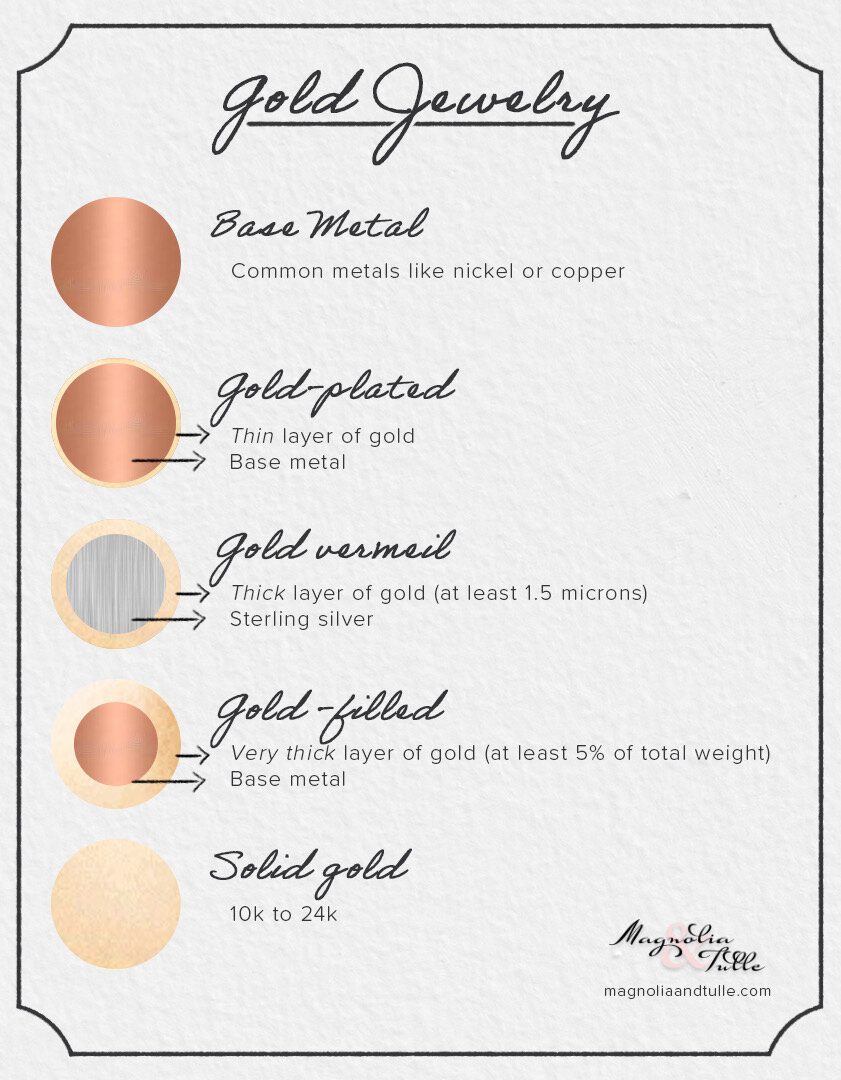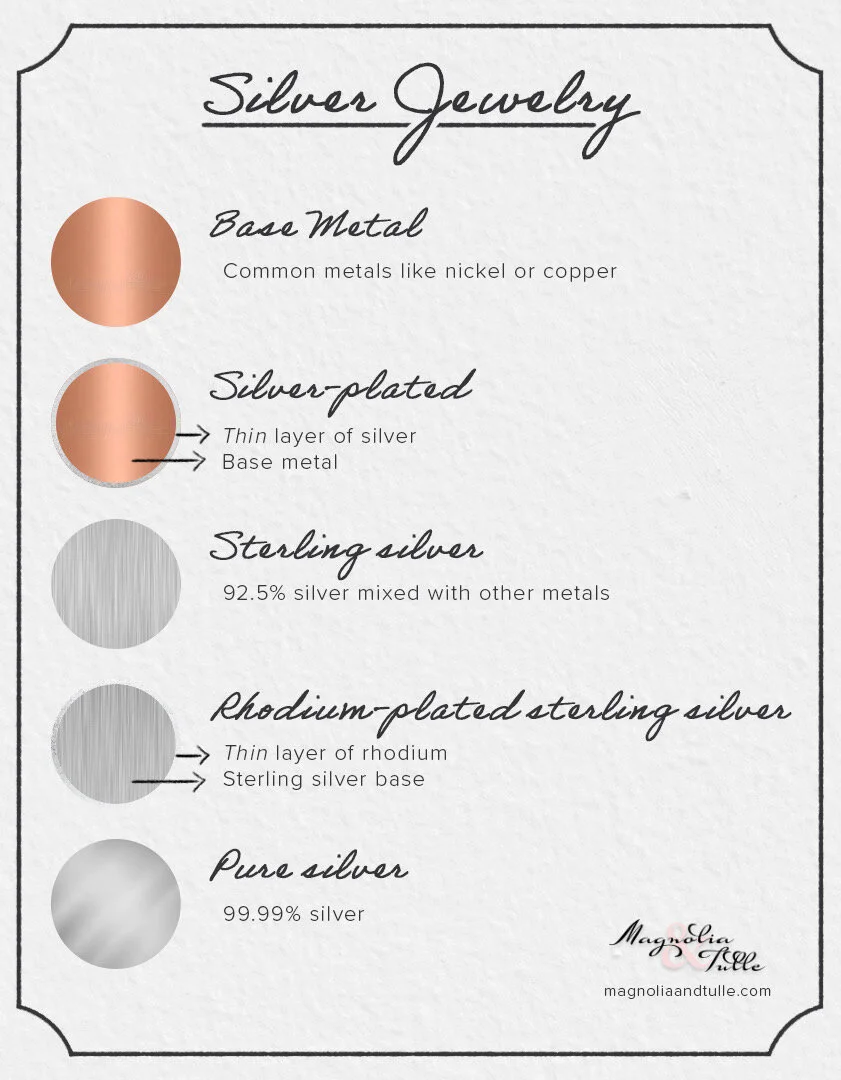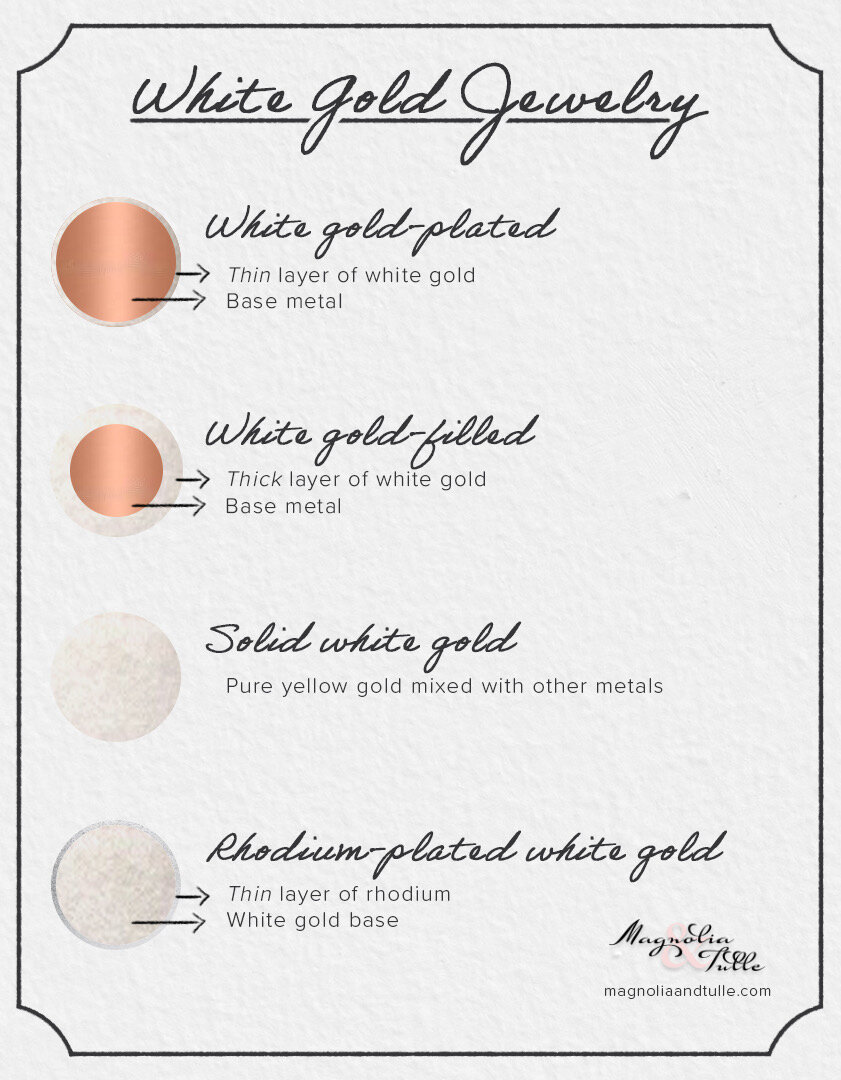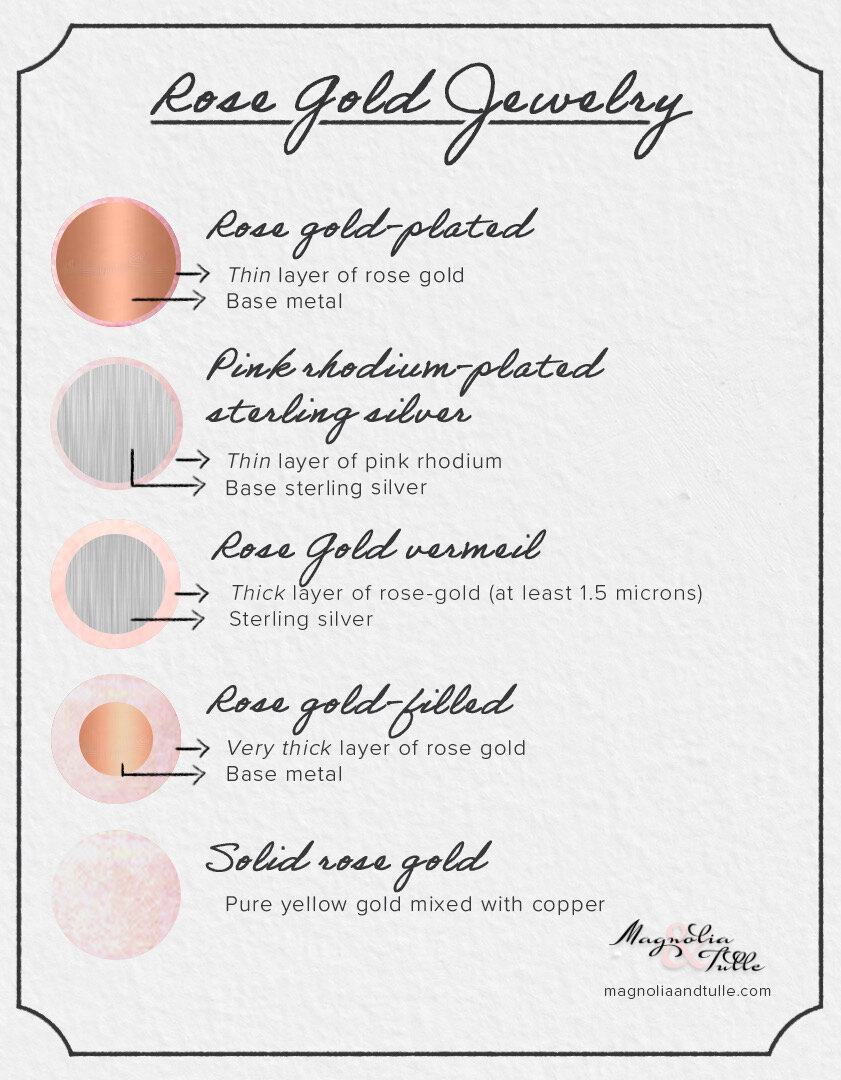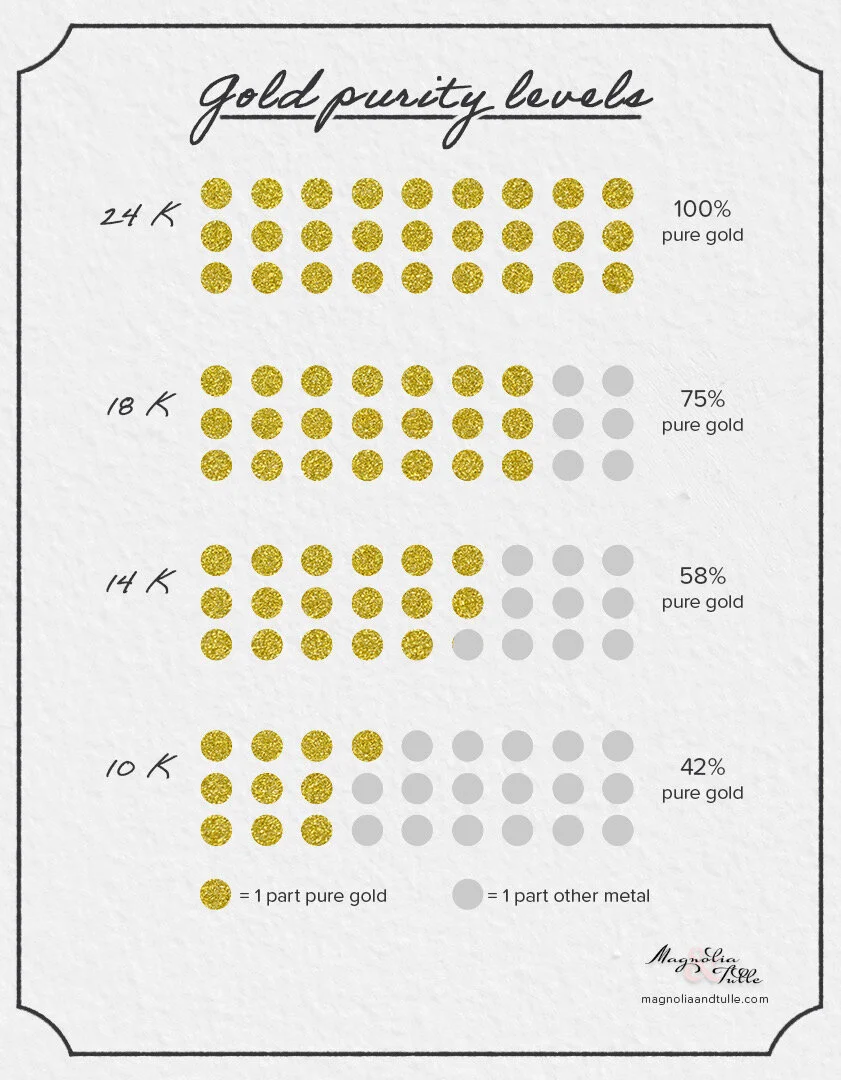What jewelry doesn’t tarnish? (and alternatives to solid gold)
We’re tired wasting money on jewelry that tarnishes and turn black a few months after purchasing. We want minimal maintenance, a reasonable price, and high quality. And not everyone can afford solid gold pieces. For the purpose of this article, we’re going to focus on rings because it’s the one piece of jewelry that is most susceptible to damage, hand washing (aka soap and water), hand sanitizer, and sweat.
Why does jewelry tarnish?
Pure gold doesn’t tarnish or turn color. But the metals (like silver, copper, and nickel) that are mixed with gold oxidizes when it’s exposed to air, sweat, makeup, and other chemicals.
Pure silver doesn’t normally react to the atmosphere. But, it slowly reacts to the sulfur in the air, which results in silver sulfide or the dark, black tarnish common to silver jewelry.
What’s the difference between the various types of gold jewelry?
Pure 24k gold is too soft for jewelry. It’s usually mixed with another alloy, resulting in 10k to 18k gold jewelry. Since gold doesn’t tarnish, the amount of other metals determines how fast your piece with discolor.
Here are the different types of jewelry organized by how fast and likely they are to tarnish.
Base metal: Cheap metals like copper are guaranteed to tarnish — and fast. Think Claire’s earrings that are advertised as “gold-tone.”
Gold-plated: Thin layer of real gold over a base metal.
PVD gold-plated: Thin layer of gold bonded to a base metal in a vacuum environment using Physical Vapor Deposition.
Gold vermeil: Thick layer of gold (at least 1.5 microns) over sterling silver.
Gold-filled: Very thick layer of gold (at least 5% of total weight) over a base metal
Solid gold, baby: Does not tarnish.
What’s the difference between the various types of silver jewelry?
Pure silver is also too soft to be used in jewelry. It’s typically mixed with another metal to strengthen the alloy, resulting in sterling silver.
The silver itself may oxidize and tarnish. Fortunately, you can polish your silver pieces to make them look good as new. But, if your pieces have another metal mixed with silver, they may blacken much faster.
With silver-colored jewelry, you have two main options: silver and white gold. (There are other metals like platinum and titanium that you could try, but they are more commonly used in engagement rings and wedding bands.)
Here are your pure silver jewelry options:
Base metal: Common metals like nickel or copper that are guaranteed to tarnish. They may be advertised as “silver-tone,” although it doesn’t contain any silver.
Silver-plated: Thin layer of silver over a base metal.
PVD silver-plated: Thin layer of silver bonded to a base metal in a vacuum environment using Physical Vapor Deposition.
Sterling silver: 92.5% silver mixed with other metals.
Rhodium-plated sterling silver: Rhodium is a hard silvery-white metal, quite rare, and five times more expensive than gold. The rhodium plate protects the sterling silver from being exposed to air, thereby preventing discoloration.
Pure silver: 99.99% silver. Too soft for jewelry.
Here are your white gold jewelry options:
White gold-plated: Thin layer of white gold over a common metal.
PVD white gold-plated: Thin layer of white gold bonded to a base metal in a vacuum environment using Physical Vapor Deposition. Not as common.
White gold-filled: Very thick layer of white gold (at least 5% of total weight) over a base metal.
Solid white gold: Not naturally white. White gold is pure yellow gold mixed with other metals (like pure silver and pure palladium) to give it a silver hue. It is tarnish-resistant but has a slight yellow hue because its made of yellow gold.
Rhodium-plated white gold: Most jewelers plate their white gold in rhodium to give it a silvery-white look, which also protects the white gold from the atmosphere. So that gorgeous bright silver color you’re used to seeing is actually rhodium, not the white gold.
What’s the difference between the various types of rose gold jewelry?
Rose gold-plated: Thin layer of rose gold over a base metal.
PVD rose gold-plated: Thin layer of rose gold bonded to a base metal in a vacuum environment using Physical Vapor Deposition.
Pink rhodium-plated sterling silver: Thin layer of pink rhodium over a base of sterling silver.
Rose gold vermeil: Thick layer of rose gold (at least 1.5 microns) over sterling silver.
Rose gold-filled: Very thick layer of rose gold (at least 5% of total weight) over a common metal.
Solid rose gold: Pure yellow gold mixed with copper (and sometimes a hint of silver) to give it a pink hue.
Does white gold, yellow gold, and rose gold have the same value?
Yes. Gold is measured in karats (k or kt), which tells you how pure it is. Don’t confuse karat (k) with carat (c), which measures the weight of a diamond.
24k is pure gold. 10k is 10 parts of pure gold out of 24 (and the rest is another type of metal). So the higher the number of karats are to 24, the purer it is. Any gold that is at least 10k is legally considered “solid gold,” although it may be mixed with another precious metal like silver, copper, and palladium.
A 14k gold-filled ring has the same amount of solid 14k gold as a 14k rose gold-filled ring. The only thing that changes is the amount of metal that is mixed to produce the color. In other words, a 14k ring is 14 parts pure gold and 10 parts other metal. Or an 18k ring is 18 parts pure gold and 6 parts other metal.
Best quality jewelry: solid gold
These are the top choices for virtually no tarnishing, lasts a lifetime, and requires minimal maintenance. But keep in mind that 18k gold is softer than 14k, so you’ll need to be extra gentle with your rings and take precautions not to bend or warp the gold.
Gold-tone: 18k or 14k gold
Silver-tone: 18k or 14k white gold
Rose gold-tone: 18k or 14k rose gold
Best balance of quality and price: gold-filled
These are the best options for minimal rusting without buying pure gold. Gold-filled jewelry can last decades and are often heirlooms. Plus, they’re more durable than 18k pieces. But don’t forget to care for your pieces to make them last as long as possible.
Gold-tone: 14k gold-filled
Silver-tone: 14k white-gold filled
Rose gold-tone: 14k rose-gold filled
Best value options for jewelry that won’t tarnish easily: PVD-plated
These are the next best options if you’re on a budget. But you’ll want to pay special attention when caring for your pieces by:
Avoiding water, especially salt and chlorine
Avoiding chemicals, including soap and hand sanitizer
Wiping down your jewelry, especially if exposed to sweat
Properly storing your pieces, such as a dust bag, when not wearing
Keep in mind that every body is different. If you sweat a lot or expose yourself a lot of chemicals, including hand sanitizer, your jewelry may tarnish more quickly.
While we previously recommended vermeil jewelry, we now suggest PVD-plated jewelry for its superior resistance to water, scratches, and tarnish. It’s an excellent choice for everyday, low-maintenance wear, especially for those with active lifestyles. After years of testing, we confidently recommend brands like D. Louise and Atolea for their high-quality PVD jewelry.
A note about gold-plated jewelry
Gold-plated options are a budget-conscious choice that offers some protection from tarnishing. Unfortunately, there is no industry standard for how thick the plating layer must be. So, you have no idea how protected your skin is from the underlying cheaper metal, which is important if say, you have a nickel allergy.
You may also find yourself with black, tarnished jewelry (or a green finger) a lot faster than you would like — aka more maintenance or having to buy new pieces altogether.
However, PVD (Physical Vapor Deposition) plated jewelry offers a more durable alternative to traditional gold plating. Unlike regular gold-plated jewelry, which can wear off quickly with exposure to water, sweat, and friction, PVD-plated pieces use a vacuum-coating process that bonds the gold to the metal at a molecular level. This makes it significantly more resistant to scratches, tarnish, and fading. It’s also waterproof, meaning less maintenance and a longer-lasting shine, making PVD-plated jewelry a superior choice for everyday wear.
Choosing your jewelry wisely can help you avoid having to replace your pieces every few months. Instead, invest in better quality rings that can last a lifetime.
Here’s a pink rhodium-plated white sapphire ring from Target — yes, Target!
